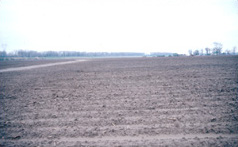Nodena site | |
 Fields at the Nodena site | |
| Nearest city | Wilson, Arkansas |
|---|---|
| Coordinates | 35°36′9″N 89°58′45″W / 35.60250°N 89.97917°W |
| Area | 305 acres (123 ha) |
| NRHP reference No. | 66000201[1] |
| Significant dates | |
| Added to NRHP | October 15, 1966[1] |
| Designated NHL | February 19, 1964[2] |
The Nodena site is an archeological site east of Wilson, Arkansas, and northeast of Reverie, Tennessee, in Mississippi County, Arkansas, United States. Around 1400–1650 CE an aboriginal palisaded village existed in the Nodena area on a meander bend of the Mississippi River. The Nodena site was discovered and first documented by Dr. James K. Hampson, archaeologist and owner of the plantation on which the Nodena site is located. Artifacts from this site are on display in the Hampson Museum State Park in Wilson, Arkansas.[3][4] The Nodena site is the type site for the Nodena phase, believed by many archaeologists to be the province of Pacaha visited by Spanish explorer Hernando de Soto in 1542.
In 1900, a prehistoric mastodon skeleton was discovered 2 miles (3.2 km) south of the Nodena site.[5] In 1964, the Nodena site was declared a National Historic Landmark[2] and in 1966 it was added to the National Register of Historic Places.[1]
- ^ a b c "National Register Information System". National Register of Historic Places. National Park Service. July 9, 2010.
- ^ a b "Nodena site". National Historic Landmark summary listing. National Park Service. Archived from the original on March 1, 2007. Retrieved February 21, 2009.
- ^ "The Virtual Hampson Museum". Center for Advanced Spatial Technologies. University of Arkansas, Fayetteville, Arkansas. Retrieved February 21, 2009.
- ^ "Hampson Archeological Museum State Park". Archeological Collection of Nodena Artifacts. Arkansas Department of Parks and Tourism, Division of State Parks. Retrieved February 21, 2009.
- ^ Williams, Steven (April 1957). "The Island 35 Mastodon: Its Bearing on the Age of Archaic Cultures in the East". American Antiquity. 22 (4): 359–372. doi:10.2307/276134. JSTOR 276134.


